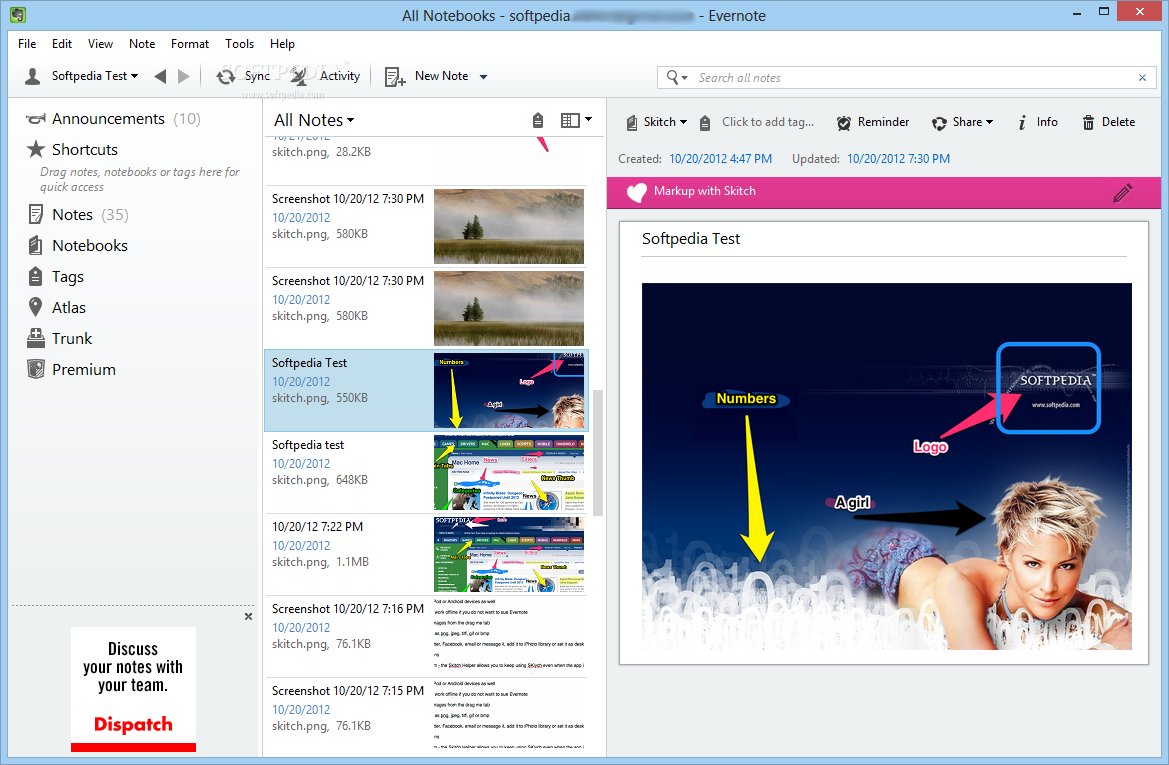Archived Evernote 5.0.3 For Mac
Evernote is a note taking organizer to collect all your notes, contacts, clippings from web sites and other miscellaneous piece of information and store them in a central location. The approach is rich text format which allows for a more structured note taking feature which can include bullet points, numbered lists, pictures and video content all on the same page.
Notebooks can be created within an Evernote account to create separation between different aspects of one's business or personal life. Data is synchronized to the cloud between Evernote apps.

The package is cross-platform with versions available for PC, Mac, iOS, Android and other platforms. The company behind Evernote also periodically releases other little apps as well. Evernote Key Features:.
Advanced note taking app. Uses notebooks to separate topics. Add pages inside notebooks. Add note, contacts, pictures, videos and more. Multi-platform including Windows, Mac, iOS and Android apps. Requires Windows Evernote is a rich note taking app.
. In the I discussed how to create note templates in Evernote for Windows. Now let’s discuss how to do it on a Mac.
Again, I want to give credit to Stephen Millard of. Many of these ideas were taken from his blog, so I recommend reading his posts on the subject first. The first step is the same as it was for Evernote for Windows. You need to create the note template and export it as a file in ENEX format (.enex) using the ‘Export Notes to Archive’ option in the file menu. I recommend creating an ‘Evernote Templates’ folder inside your Documents folder and saving the template file there. Open the template file in your favourite text editor and delete the ‘created’ and ‘updated’ tags and all the numbers/text between those tags (see for more details).
Once that’s finished, save and close the template file. Now it’s time to create an AppleScript. Open the AppleScript Editor and paste in the following code. 1 2 3 4 tell application 'Evernote' activate import '/Users/Your OS X Username Here/Documents/Evernote Templates/Sample Template.enex' to ' 1. Inbox' without tags end tell tell application 'Evernote' activate import '/Users/Your OS X Username Here/Documents/Evernote Templates/Sample Template.enex' to '1.
Evernote For Mac User Guide
Inbox' without tags end tell You’ll need to change the path to the template file to match your needs, and, if you want, you can change the notebook into which the template file is imported as well. Once that is finished, create a folder named ‘Evernote’ in the following directory: /Library/Scripts. You’ll know you’re in the right directory if you see other folders such as ‘ColorSync’, ‘Folder Actions’, ‘iChat’, etc. Save the AppleScript in the /Library/Scripts/Evernote folder that you just created. Before you exit the AppleScript Editor, open ‘Preferences’ and, under the ‘General’ tab, make sure the ‘Show Script menu in menu bar’ option is checked. A little paper-scroll icon should now appear in your menu bar.
Close the AppleScript Editor. Now it’s time to test out the script. Click on the paper-scroll icon in the menu bar. Mouse over the Evernote folder and click on the note template script you just created. The note template should appear inside the notebook you specified. If the script doesn’t seem to be working, put the template file directly inside your Documents folder and use the following code.
1 2 3 4 tell application 'Evernote' activate import '/Users/Your OS X Username Here/Documents/Sample Template.enex' to ' 1. Inbox' without tags end tell tell application 'Evernote' activate import '/Users/Your OS X Username Here/Documents/Sample Template.enex' to '1. Inbox' without tags end tell You can create as many templates/scripts as you’d like, and you can launch them all directly from the menu bar. Stay tuned for Part 3 where I’ll explain how to integrate the Evernote template system into your GTD workflow.
I just tested the script on an old Macbook running Snow Leopard (OS X 10.6.8), and it worked fine. Re-tested it on a newer Macbook Pro running Lion, and it didn’t work. I fooled around with the code a little bit. If I move the template file directly into the Documents folder (not in the Evernote Templates folder) and update the script to match, it seems to work on the newer Macbook Pro. Strange behaviour since they are both running the same version of Evernote.
I’ll update the post and add an alternate version of the script. Let me know if it works for you. Brian Binder. I just found your blog and am currently trying to integrate GTD into my Evernote. I am working on a MacBook and have tried to install the script. When I am in AppleScript and I try to save the script to the Evernote file in the “Library/Scripts”, the prompt to save gives a pull down window of where to save the script.
Evernote Mac App
There is no option for the Library and it won’t give me the option to type “/Library/Scripts”. Any advice or help would be great. I am looking forward to using your system and giving feedback to my partner about using it as well!